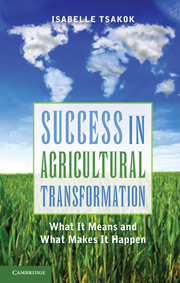Book contents
- Frontmatter
- Contents
- Figures and Table
- Preface
- Acknowledgments
- Summary
- Introduction
- Part One The many faces of agricultural transformation in an industrializing world and what it means
- Part Two Success in Agricultural Transformation: What Makes It Happen?
- III Necessary Conditions
- IV Necessary but Not Sufficient Conditions?
- V Missing Conditions
- VI The Public Foundations of Private Agriculture
- Appendices
- Select Bibliography
- Index
III - Necessary Conditions
from Part Two - Success in Agricultural Transformation: What Makes It Happen?
Published online by Cambridge University Press: 05 June 2012
- Frontmatter
- Contents
- Figures and Table
- Preface
- Acknowledgments
- Summary
- Introduction
- Part One The many faces of agricultural transformation in an industrializing world and what it means
- Part Two Success in Agricultural Transformation: What Makes It Happen?
- III Necessary Conditions
- IV Necessary but Not Sufficient Conditions?
- V Missing Conditions
- VI The Public Foundations of Private Agriculture
- Appendices
- Select Bibliography
- Index
Summary
Introduction
Summary. Although “newly” established, Canada, Australia, and New Zealand are high-income industrialized economies. Primarily urban, their agriculture and agro-food sectors nevertheless remain important earners of foreign exchange. Since their founding and over the 20th century, their governments have been able to achieve success in the transformation of their agricultures. Their agricultures have benefited from meeting the five conditions. As in most OECD countries, their agriculture and agro-food sectors received substantial market-distorting price supports and subsidies after WWII. Economists rightly argue that these subsidies reduce the efficiency of global resource allocation, hence global growth. However, the success of their agricultural transformation raises the difficult question of whether these subsidies have played an essential role in such transformation. The sustained high productivity performance of agriculture in Australia and New Zealand without these price-distorting subsidies make a strong case that they are not.
- Type
- Chapter
- Information
- Success in Agricultural TransformationWhat It Means and What Makes It Happen, pp. 193 - 212Publisher: Cambridge University PressPrint publication year: 2011



